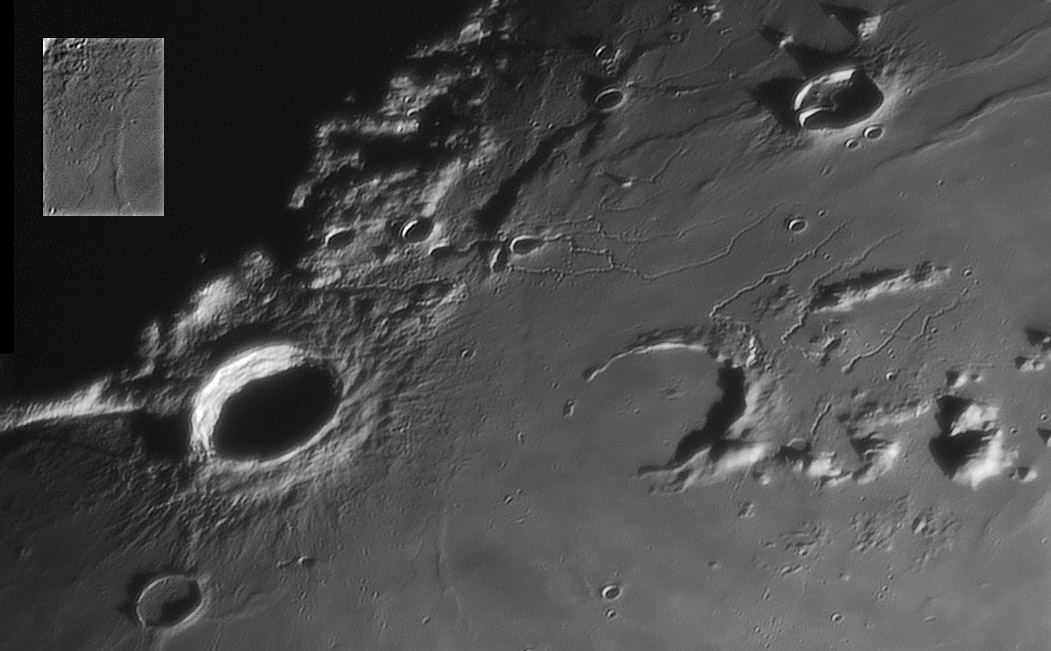Difference between revisions of "May 23, 2010"
| Line 1: | Line 1: | ||
__NOTOC__ | __NOTOC__ | ||
=A New Rille?= | =A New Rille?= | ||
| − | |||
<!-- ws:start:WikiTextHeadingRule:1:<h1> --> | <!-- ws:start:WikiTextHeadingRule:1:<h1> --> | ||
<!-- ws:start:WikiTextLocalImageRule:16:<img src="/file/view/LPOD-May23-10.jpg/143962267/LPOD-May23-10.jpg" alt="" title="" /> -->[[File:LPOD-May23-10.jpg|LPOD-May23-10.jpg]]<!-- ws:end:WikiTextLocalImageRule:16 --><br /> | <!-- ws:start:WikiTextLocalImageRule:16:<img src="/file/view/LPOD-May23-10.jpg/143962267/LPOD-May23-10.jpg" alt="" title="" /> -->[[File:LPOD-May23-10.jpg|LPOD-May23-10.jpg]]<!-- ws:end:WikiTextLocalImageRule:16 --><br /> | ||
| − | <em>image by [mailto:nsmith10000@yahoo.co.uk Nick Smith], Oxford, England</em><br /> | + | <em>image by [mailto:nsmith10000@yahoo.co.uk" rel="nofollow Nick Smith], Oxford, England</em><br /> |
<br /> | <br /> | ||
| − | There are so many rilles on the east side of the Aristarchus Plateau that another shouldn't matter. But I am excited to detect one that I don't remember seeing before. Nick's image has such smooth tonality and high resolution that I enhanced the contrast and out popped a short sinuous rille segment. I extracted an enhanced snippet of it - upper right; can you see where in the image it came from? The rille is similar to others visible except it is narrower, shallower and hence harder to see. The north end disappears in a clump of small secondary craters from Aristarchus, and the southern end just seems to stop. I searched thru past LPODs - typically the best telescopic images in existence - and found that it is just visible (but uncommented upon) in an earlier [http://lpod.wikispaces.com/August+10%2C+2008 scene], and it is quite well seen in an USGS processed Lunar Orbiter IV [http://www.lpi.usra.edu/resources/lunarorbiter/images/preview/4150_h3.jpg image.] I have not spotted this rille on any traditional lunar map, but eagle-eyed John Guest and John Murray included it on their Orbiter based [http://lpod.wikispaces.com/July+29%2C+2009 chart] of 1976.<br /> | + | There are so many rilles on the east side of the Aristarchus Plateau that another shouldn't matter. But I am excited to detect one that I don't remember seeing before. Nick's image has such smooth tonality and high resolution that I enhanced the contrast and out popped a short sinuous rille segment. I extracted an enhanced snippet of it - upper right; can you see where in the image it came from? The rille is similar to others visible except it is narrower, shallower and hence harder to see. The north end disappears in a clump of small secondary craters from Aristarchus, and the southern end just seems to stop. I searched thru past LPODs - typically the best telescopic images in existence - and found that it is just visible (but uncommented upon) in an earlier [http://lpod.wikispaces.com/August+10%2C+2008 scene], and it is quite well seen in an USGS processed Lunar Orbiter IV [http://www.lpi.usra.edu/resources/lunarorbiter/images/preview/4150_h3.jpg" rel="nofollow image.] I have not spotted this rille on any traditional lunar map, but eagle-eyed John Guest and John Murray included it on their Orbiter based [http://lpod.wikispaces.com/July+29%2C+2009 chart] of 1976.<br /> |
<br /> | <br /> | ||
| − | <em>[mailto:tychocrater@yahoo.com Chuck Wood]<br /> | + | <em>[mailto:tychocrater@yahoo.com" rel="nofollow Chuck Wood]<br /> |
<strong>Note:</strong> Thanks for the telescopic images submitted recently - keep them coming!</em><br /> | <strong>Note:</strong> Thanks for the telescopic images submitted recently - keep them coming!</em><br /> | ||
<br /> | <br /> | ||
| Line 16: | Line 15: | ||
<strong>Related Links</strong><br /> | <strong>Related Links</strong><br /> | ||
Rükl plate [http://the-moon.wikispaces.com/R%C3%BCkl+18 18]<br /> | Rükl plate [http://the-moon.wikispaces.com/R%C3%BCkl+18 18]<br /> | ||
| − | [http://www.pbase.com/nicksmith/image/121498403/original Original image]<br /> | + | [http://www.pbase.com/nicksmith/image/121498403/original" rel="nofollow Original image]<br /> |
<br /> | <br /> | ||
<hr /> | <hr /> | ||
| − | <div>You can support LPOD when you buy any book from Amazon thru [http://www.lpod.org/?page_id=591 LPOD!]<br /> | + | <div>You can support LPOD when you buy any book from Amazon thru [http://www.lpod.org/?page_id=591" rel="nofollow LPOD!]<br /> |
</div> | </div> | ||
| − | |||
---- | ---- | ||
===COMMENTS?=== | ===COMMENTS?=== | ||
Click on this icon [[image:PostIcon.jpg]] at the upper right to post a comment. | Click on this icon [[image:PostIcon.jpg]] at the upper right to post a comment. | ||
Revision as of 18:23, 4 January 2015
A New Rille?

image by " rel="nofollow Nick Smith, Oxford, England
There are so many rilles on the east side of the Aristarchus Plateau that another shouldn't matter. But I am excited to detect one that I don't remember seeing before. Nick's image has such smooth tonality and high resolution that I enhanced the contrast and out popped a short sinuous rille segment. I extracted an enhanced snippet of it - upper right; can you see where in the image it came from? The rille is similar to others visible except it is narrower, shallower and hence harder to see. The north end disappears in a clump of small secondary craters from Aristarchus, and the southern end just seems to stop. I searched thru past LPODs - typically the best telescopic images in existence - and found that it is just visible (but uncommented upon) in an earlier scene, and it is quite well seen in an USGS processed Lunar Orbiter IV " rel="nofollow image. I have not spotted this rille on any traditional lunar map, but eagle-eyed John Guest and John Murray included it on their Orbiter based chart of 1976.
" rel="nofollow Chuck Wood
Note: Thanks for the telescopic images submitted recently - keep them coming!
Technical Details
Jan 2010, taken around 21:35 UT. C14 + Red filter + Lumenera Infinity 2-1M camera
Related Links
Rükl plate 18
" rel="nofollow Original image
COMMENTS?
Click on this icon File:PostIcon.jpg at the upper right to post a comment.



